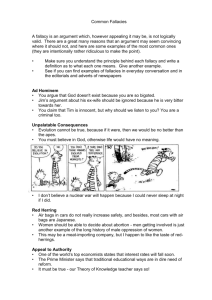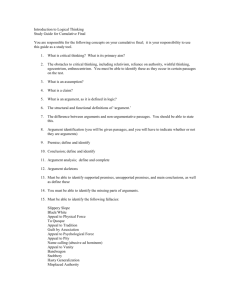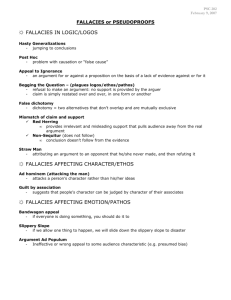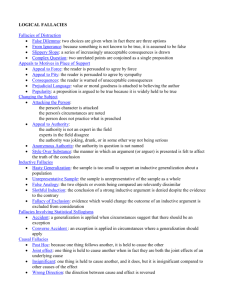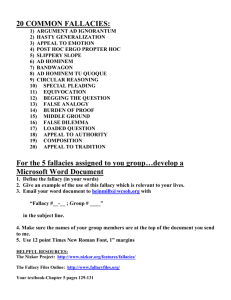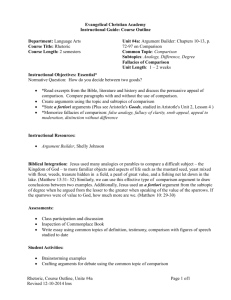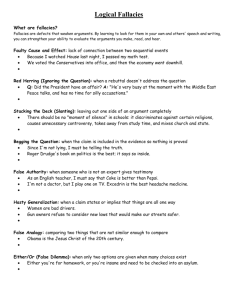Arguments
advertisement
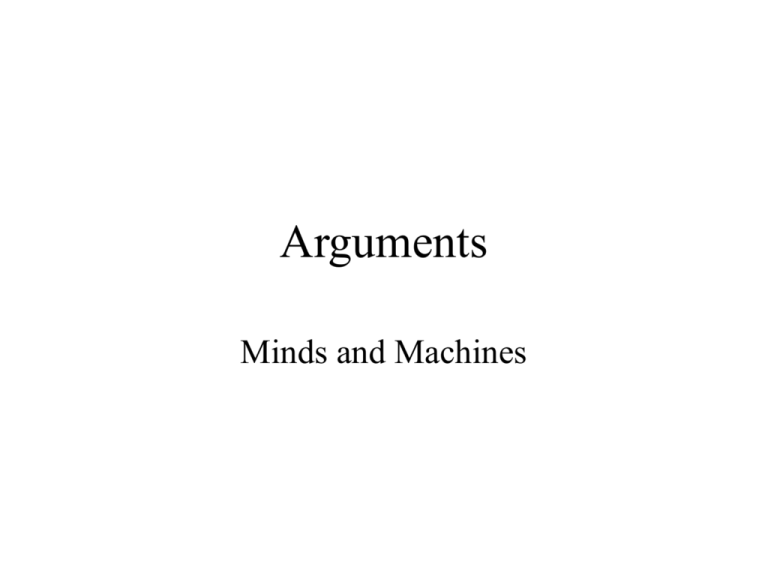
Arguments Minds and Machines Arguments • When people think of an argument, they usually think of a fight between two people (‘they’re having an argument’). • In contrast, in philosophy, an argument is a piece of reasoning for the truth of a certain claim. Thus, one person can give an argument for or against something. Premises and Conclusion • An argument has any number of supporting claims, and 1 supported claim. • The supporting claims are the premises of the argument. • The supported claim is the conclusion. • Example: ‘We shouldn’t get pepperoni on the pizza, because pepperoni makes me sick.’ – 1 premise: ‘Pepperoni makes me sick’ – conclusion: ‘We shouldn’t get pepperoni on the pizza’ Validity and Soundness • A good argument needs to satisfy 2 criteria: – 1. The conclusion should follow from the premises; the truth of the premises should make the conclusion (likely to be) true – 2. The premises should be acceptable; the premises should (likely to be) true • An argument is valid if it satisfies the first criterion. Otherwise, it is invalid. • An argument is sound if it satisfies both criteria. Otherwise, it is unsound. Deduction and Induction • A deductive argument is one where the truth of the conclusion is (claimed to be) guaranteed by the truth of the premises. – Mathematics is deductive • An inductive argument is one where the truth of the conclusion is (claimed to be) more likely given the truth of the premises. – Science (and most of real life) is inductive Attacking Arguments • You attack arguments by showing that it does not satisfy one (or both) of the criteria of a good argument. Thus, either you show that the premises are unacceptable, or you show that it is unreasonable to draw the conclusion as stated, even if the premises would be true. • You do not attack an argument by showing that its conclusion is false! Attacking Arguments II • As we saw, you can’t attack an argument by giving an argument for the opposite conclusion. However, the reverse holds as well: even if you do successfully attack an argument with a certain conclusion, you have thereby not given any argument in favor of the opposite conclusion. • In sum, attacking an argument for a certain conclusion is completely different from giving an argument in favor of the opposite conclusion. Fallacies • Bad arguments are called fallacies. • There are many fallacies of which many people think that they are good arguments. • Fallacies usually follow certain patterns, so there are several categories of common fallacies. • You can see fallacies around you all the time once you recognize these patterns. Fallacies of Relevance • Fallacies that violate the first criterion are fallacies of relevance. In other words, any time the conclusion cannot reasonably be drawn from the premises, we are dealing with a fallacy of relevance. – – – – – Ad Hominem Appeal to Authority Red Herring Appeal to Fear, Force, Pity, Vanity, etc. Appeal to Ignorance Ad Hominem • The Ad Hominem Fallacy is committed when someone rejects a belief or argument based on its source. Examples: – Bill Clinton’s proposal is bad, because he had sex in the White House (abusive ad hominem) – Of course he opposes rent control. He owns two apartment buildings himself! (circumstantial ad hominem) – John Kerry criticizes George Bush’s military record? Wait, didn’t Kerry get those 3 purple hearts by blowing up some innocent Vietnamese? (inconsistency ad hominem, pseudorefutation or ‘tu quoque’) Appeal to Authority • Inappropriate Authority: – According to my dad … – Einstein said … [something about evolution] • Unidentified Authority: – Studies show … – Experts agree … – Scientifically proven! • Appeal to the Masses: – Everybody knows … Red Herring • Sometimes the premises seem related to the conclusion, but they really aren’t: you are being led down the wrong path. Example: – I can't believe you thought that latest Disney movie was ok for children to watch. Disney pays 12-year old girls 31 cents an hour to sow their products together. Appeal to Emotions (Fear, Pity, Vanity, etc) • Fear: – If you don’t believe in God, God sure won’t be happy about that! • Pity: – I deserve an A in the class because my mom was really sick and so I couldn’t concentrate • Vanity: – Intelligent people like yourself deserve [fill in any product here] Appeal to Ignorance • An appeal to ignorance is made when one argues that something is the case since no one has shown that it is not the case: – Smoking is ok, since no one has proven that it is bad for your health. – Our factory output shouldn’t be restricted for environmental reasons, since no one has shown that the green house effect really exists. Fallacies of Assumption • A fallacy of assumption violates the second criterion of a good argument. Thus, a fallacy of assumption is an argument that makes a dubious assumption. – False Dilemma • Perfectionist Fallacy • Line-Drawing Fallacy – Straw Man – Slippery Slope – Begging the Question False Dilemma • An argument assumes a false dilemma when it assumes that one of two cases must be true, where in fact there are other options as well. Examples: – Since you’re not a capitalist, you must be a communist! – You’re either with us, or against us. – Are you a Democrat or a Republican? – Nature or nurture? Perfectionist Fallacy • The perfectionist fallacy presents us with a kind of ‘all or nothing’ false dilemma: – We shouldn’t give aid to countries where people are starving, because we can’t eradicate hunger completely. – Since no one has proven with absolute certainty that God exists, it is just as rational to believe that God does not exist as it is to believe that God does exist. Line-Drawing Fallacy • Another kind of false dilemma: Either we can draw a line between two things, or there is no difference between the two at all: – Abortion is murder from the moment of conception, since we can’t draw the line before which the fetus is not a person, and after which the fetus is. Straw Man • A Straw Man argument attacks something by attacking a helpless caricature of that something: it often distorts the original by exaggeration. Example: – The movement to allow prayer in public school classrooms is a major threat to our freedom. The advocates of prayer in school want to require every school child to participate in a Christian religious program prior to every school day. Slippery Slope • A slippery slope fallacy makes a dubious assumption that one thing will lead to another – If the “experts” decide today that we should have fluorides in our tea, coffee, frozen orange juice, lemonade, and every cell of our bodies, what’s next? Tranquilizers to avoid civil disorders? What about birth-control chemicals to be routed to the water in certain ethnic neighborhoods? Begging the Question • Circular reasoning: – God exists because the bible says so. … What, why we can trust what the Bible says? Easy, the Bible is the word of God. – Of course my salary is higher than yours, because my work is more important. …You’re asking me why it is more important? Well, my salary is higher, isn’t it? • The “True Scotsman” Fallacy: – All Germans like sauerkraut. … Oh, your brother-in-law is German and he doesn’t like sauerkraut? Well, he is not a true German then, is he?
